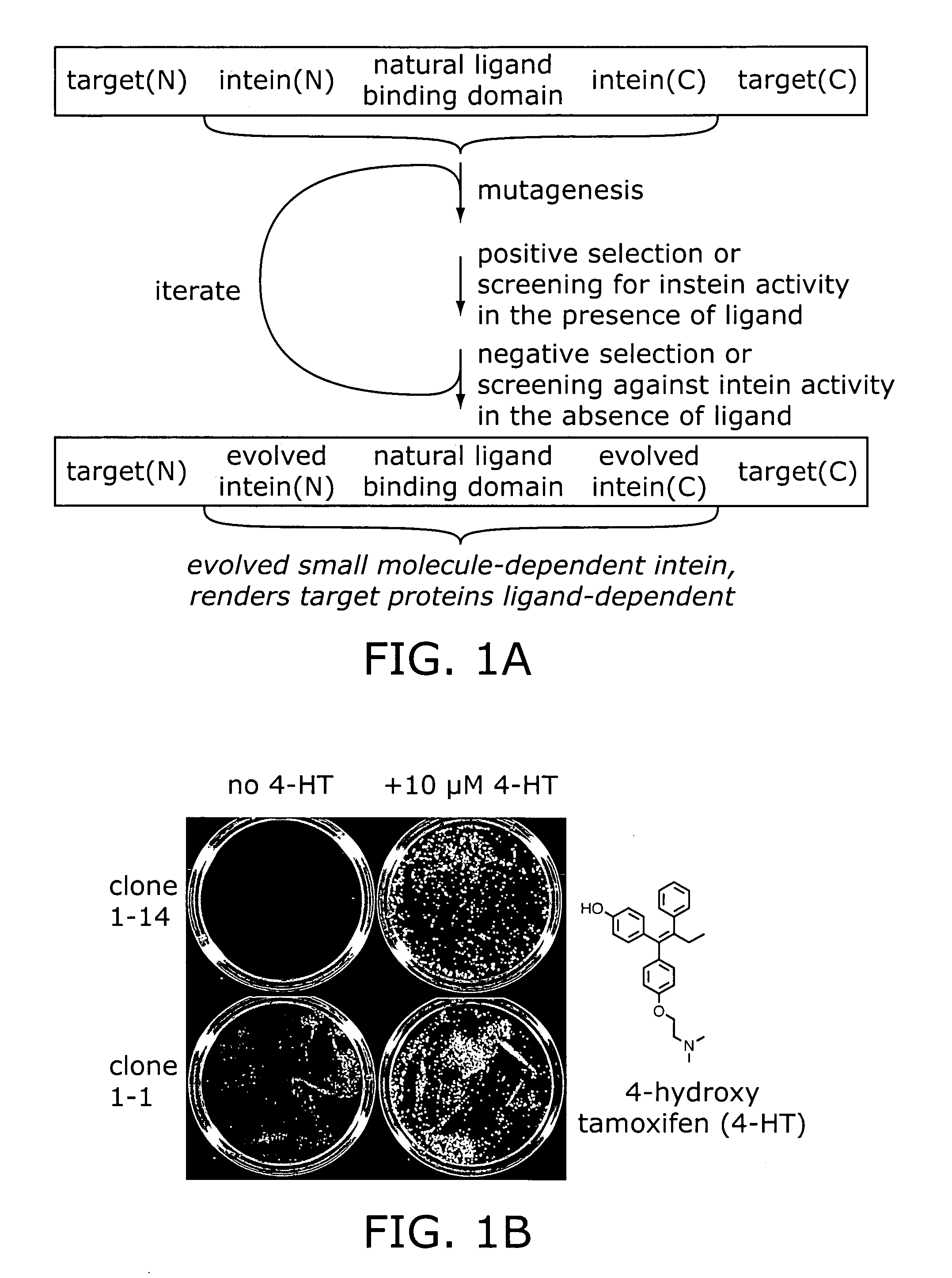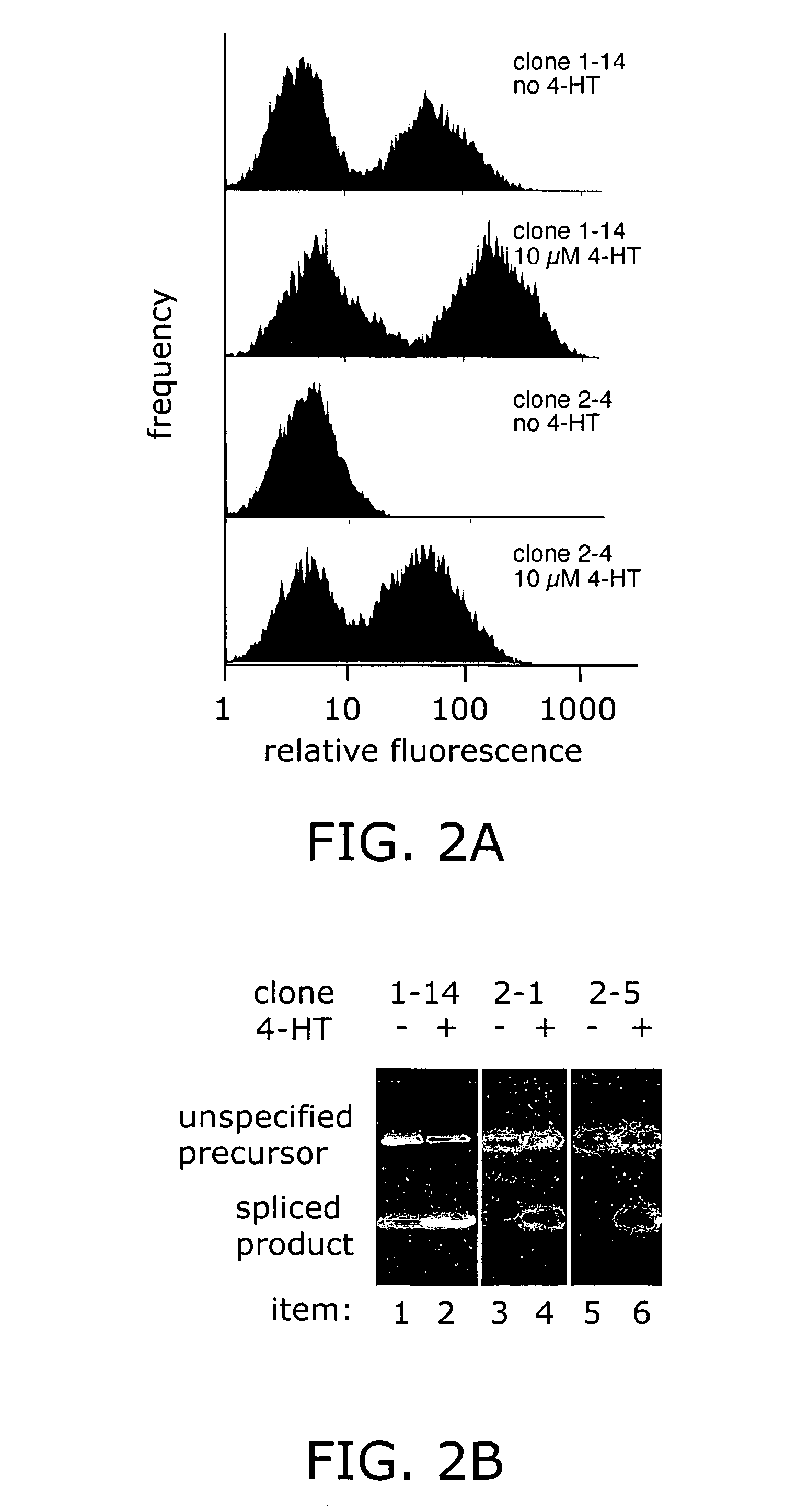Ligand-dependent protein splicing
a ligand-dependent protein and splicing technology, applied in the field of ligand-dependent protein splicing, can solve the problems of reducing reducing the efficiency of the protein, so as to reduce or eliminate the activity of the protein
- Summary
- Abstract
- Description
- Claims
- Application Information
AI Technical Summary
Benefits of technology
Problems solved by technology
Method used
Image
Examples
example 1
Directed Evolution of Ligand Dependence: Small-Molecule-Activated Protein Splicing
Materials and Methods
[0089]Molecular Biology Reagents. Restriction enzymes, Vent DNA polymerase, and T4 DNA ligase were purchased from New England Biolabs. Oligonucleotides were synthesized by using an ABI Expedite 8909 DNA synthesizer. Geldanamycin (GDA), cycloheximide, and 4-hydroxytamoxifen (4-HT) were purchased from Sigma.
[0090]Yeast Strains and Standard Methods. S. cerevisiae strain 1284 (leu2-3,112 ura3-52 his3-Δ200 lys2-801 trpl-Δ901 suc2-A9) was used for the geneticin-resistance selection and in screening the GFP libraries. Strain 1285 (ade2-101, leu2-3,112 ura3-52 his3-Δ200 trpl-Δ901 suc2-Δ9) was used in the Ade2 experiments. Strain RDY96 (erg6Δ::TRP1 pdr1Δ::KanMX pdr3::HIS3 ade2-1 trpl-1 his3-11,15 ura3-52 leu2-3,112 canl-100) was used in the LacZ experiments and for the individual clone GFP flow cytometry and Western blot results reported (see FIGS. 2–4). Cultures were grown at 30° C. in yea...
example 2
Elucidation of the Mammalian Hedgehog Pathway Using a Ligand-Dependent Intein
[0124]The generality of the ligand-dependent intein described in Example 1 (ER-intein), its speed of splicing in response to 4-HT, and its control at the post-translational level make it a valuable tool in the study of mammalian systems. One area in which it may prove particularly useful is in the study of developmental signaling pathways, in which the activation of certain proteins at specific times is responsible for important developmental events. One example of this type of signaling pathway is the Hedgehog pathway. Insertion of the ER-intein can provide control over a single component of this complex pathway, thus providing insight into how the pathway operates.
[0125]In order to realize this goal of using the ER-intein to study the Hedgehog pathway, it is necessary to show that the ER-intein construct shows the same ligand-dependent activity in mammalian cells that it does in yeast. A vector containing...
PUM
| Property | Measurement | Unit |
|---|---|---|
| structure | aaaaa | aaaaa |
| α | aaaaa | aaaaa |
| β | aaaaa | aaaaa |
Abstract
Description
Claims
Application Information
 Login to View More
Login to View More - R&D
- Intellectual Property
- Life Sciences
- Materials
- Tech Scout
- Unparalleled Data Quality
- Higher Quality Content
- 60% Fewer Hallucinations
Browse by: Latest US Patents, China's latest patents, Technical Efficacy Thesaurus, Application Domain, Technology Topic, Popular Technical Reports.
© 2025 PatSnap. All rights reserved.Legal|Privacy policy|Modern Slavery Act Transparency Statement|Sitemap|About US| Contact US: help@patsnap.com



